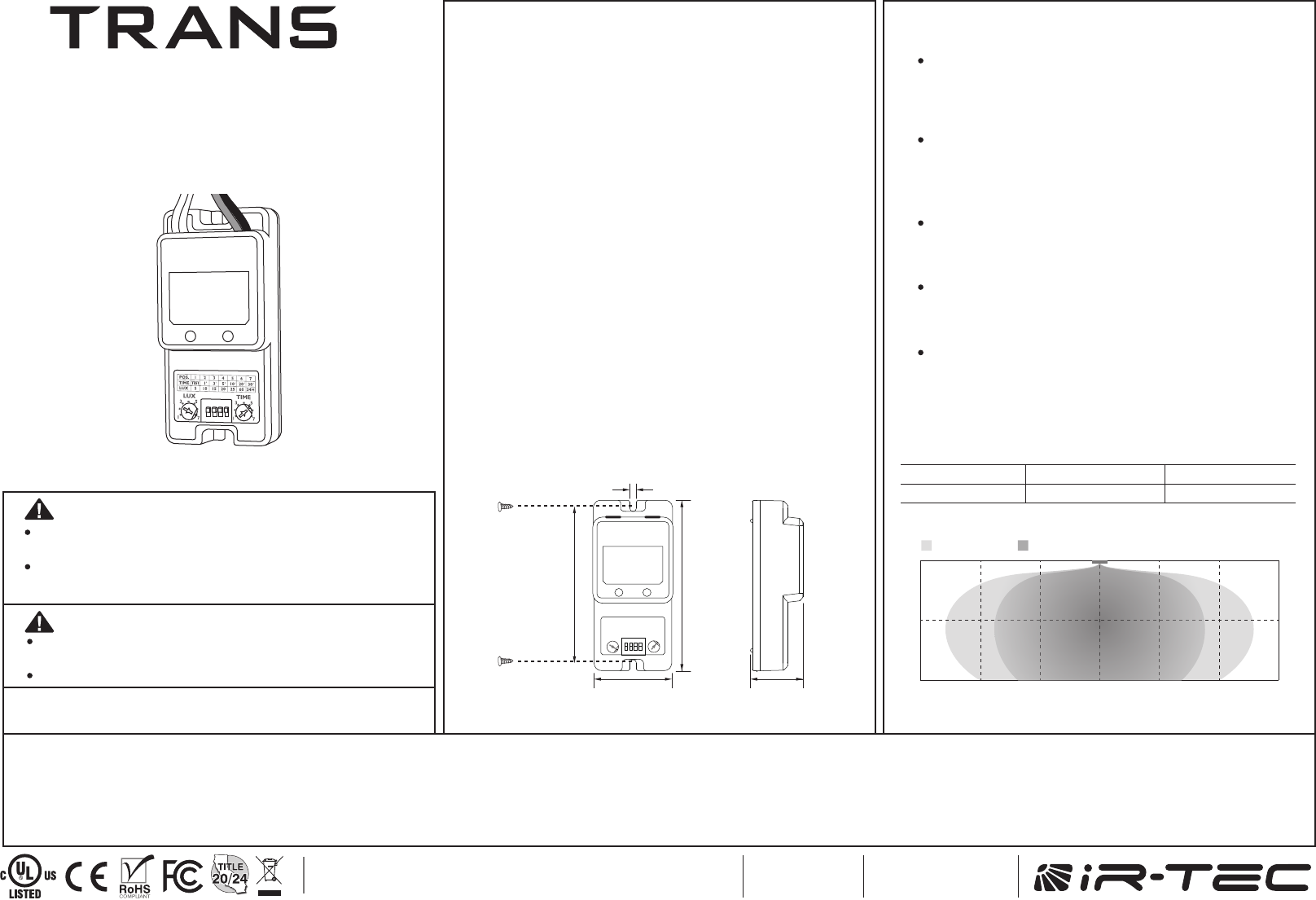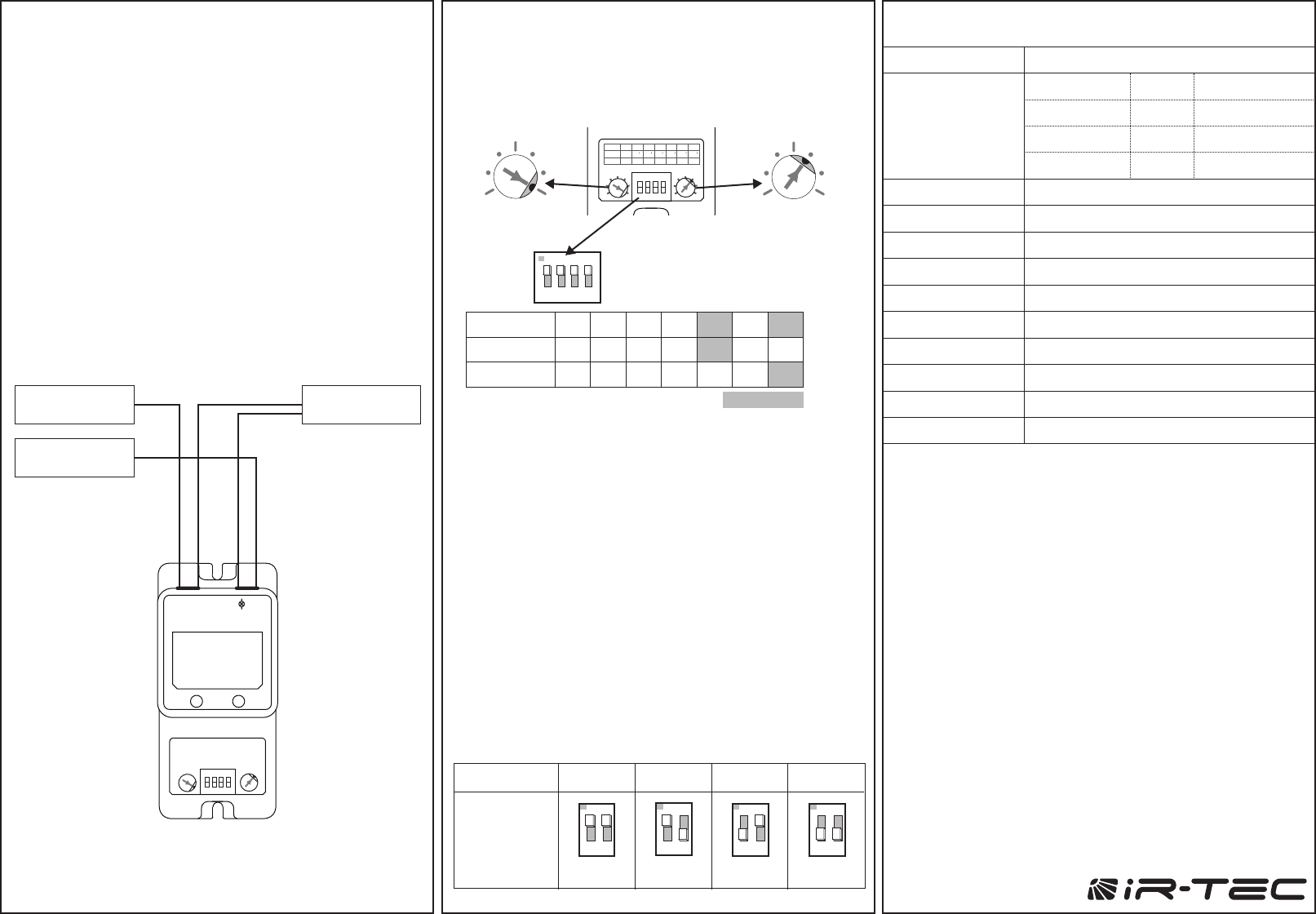IR TEC HS1X0900 TRANS-HFD User Manual 058 10900 002 IM EN LMS 109
IR-TEC International Ltd. TRANS-HFD 058 10900 002 IM EN LMS 109
IR TEC >
Contents
- 1. User Manual (LMD-109).pdf
- 2. User Manual (LMD-509).pdf
- 3. User Manual (LMS-109).pdf
User Manual (LMS-109).pdf

OVERVIEW
The LMS-109 series is a line voltage occupancy sensor
designed for OEM lighting fixture integration to provide
occupancy sensing control. This occupancy sensor
employs an advanced High Frequency Doppler (HFD)
sensing technology to provide superior sensing
performance of minor motion like typing, writing, or reading.
The HFD technology operates with high frequency radio
waves which are capable of detecting the occupant's
presence and movements without requiring unobstructed
line-of-sight like PIR sensors. Thus, the HFD sensor can
detect through non-metallic material like plastic, glass,
plywood or plaster board.
The Accu-Set digitalized potentiometers make setting the
sensor easier, faster and more accurate than conventional
analog ones. 4 levels of sensitivity can be selected via DIP
switch settings to provide different coverage. An exclusive
Hybrid Switching technology makes the LMS-109 series
perfect to control lighting with exceptionally high inrush
current (HIC) during switching, such as multiple LED lights
connected in parallel. The sensor comes with an ambient
light sensor (ALS) to inhibit switching on the light if the
ambient light level is higher than the threshold set.
APPLICATION NOTES
DETECTION PATTERN
Avoid placing the sensor in an area surrounded with
metallic wall which may block or absorb the radio
wave. If possible, place the sensor to the opening
as close as possible.
Fluorescent light may cause interference to the HFD
sensor operation, and result in lighting permanent
on. If possible, avoid placing the HFD sensor within
1m (3ft.) of fluorescent light.
Avoid sensor placement facing doors, corridors or
exits as HFD sensor may detect the traffics at
adjacent area.
HFD sensors are best for use in areas with partitions
and high dividers, or high level of minor motion
activities.
The HFD sensor is more sensitive to the movements
“toward” than “across” the sensor, so ensure to
place the sensor at the position “toward” the
movements of occupant.
Line Voltage Occupancy Sensor
LMS-109 series
INSTALLATION INSTRUCTIONS
20 302030 10 30
6 969 3 30
0
3
6
0
10
20
(ft)
(ft)
(m)
(m) Minor motionMajor motion
Mounting Height
Coverage*
3 m (10 ft)
180 m2 (2,000 ft2)
6 m (20 ft)
100 m2 (1,200 ft2)
*Sensitivity 100%
DIMENSIONS
LMS-109
3.6mm
(0.14”)
43mm
(1.69”)
29mm
(1.69”)
92mm
(3.6”)
84mm
(3.3”)
P/N: 058-10900-002 Printed in Taiwanwww.irtec.com
This product may be covered by one or more U.S. patents or patent applications.
Please visit www.irtec.com for more information.
IR-TEC hereby declares that the LMS-109 complies with Directive 2014/53/EU issued by the Commission of the
European Community. The complete declaration of conformity is available on our website: www.irtec.com
The frequency and maximum transmitted power in EU are listed as 5800 MHz: -11.28dBm.
Risque de choc électrique - Débranchez l'alimentation avant
l'entretien.
Ouvrir Type commutateurs optoélectroniques.
Risk of Electric Shock - Disconnect power supply before
servicing.
Open Type Photoelectric Switches.
CAUTION
PRUDENCE
Install the sensor at least 1ft. away from any occupant.
Indoor dry location use only
Utilisation a L'interieur Uniquement
IR-TEC International Ltd.
6 Rong An Road
Luzhu Taoyuan 338
TAIWAN
IR-TEC America, Inc.
590 W. Central Avenue Suite C
Brea, CA 92821
USA
This device complies with Part 15 of the FCC Rules. Operation is subject to the following two conditions: (1) This
device may not cause harmful interference, and (2) this device must accept any interference received, including
interference that may cause undesired operation.
This equipment has been tested and found to comply with the limits for a Class B digital device, pursuant to Part
15 of the FCC Rules. These limits are designed to provide reasonable protection against harmful interference in
a residential installation. This equipment generates, uses and can radiate radio frequency energy and, if not
installed and used in accordance with the instructions, may cause harmful interference to radio communications.
However, there is no guarantee that interference will not occur in a particular installation. If this equipment does
cause harmful interference to radio or television reception, which can be determined by turning the equipment off
and on, the user is encouraged to try to correct the interference by one of the following measures:
Radiation Exposure Statement:
This equipment complies with ISED radiation
exposure limits set forth for an uncontrolled
environment. This equipment should be installed and
operated with minimum distance 20cm between the
radiator & your body.
Déclaration d'exposition aux radiations:Cet
équipement est conforme aux limites d'exposition aux
rayonnements ISED établies pour un environnement
non contrôlé. Cet équipement doit être installé et
utilisé avec un minimum de 20 cm de distance entre la
source de rayonnement et votre corps.
-Reorient or relocate the receiving antenna.
-Increase the separation between the equipment and receiver.
-Connect the equipment into an outlet on a circuit different from that to which the receiver is
connected.
-Consult the dealer or an experienced radio/TV technician for help.
FCC Caution: Any changes or modifications not expressly approved by the party responsible for
compliance could void the user's authority to operate this equipment.
This transmitter must not be co-located or operating in conjunction with any other antenna or transmitter.
Radiation Exposure Statement: This equipment complies with FCC radiation exposure limits set forth
for an uncontrolled environment. This equipment should be installed and operated with minimum
distance 20cm between the radiator & your body.
Federal Communication Commission Interference Statement Industry Canada statement:
IC ID:22993-X09HS1AC602
This device complies with ISED’s licence-exempt RSSs. Operation is subject
to the following two conditions: (1) This device may not cause harmful
interference, and (2) this device must accept any interference received,
including interference that may cause undesired operation.
Le présent appareil est conforme aux CNR d’ ISED applicables aux appareils
radio exempts de licence. L’exploitation est autorisée aux deux conditions
suivantes : (1) le dispositif ne doit pas produire de brouillage préjudiciable,
et (2) ce dispositif doit accepter tout brouillage reçu, y compris un brouillage
susceptible de provoquer un fonctionnement indésirable.
FCC ID:NRIHS1X0900
IC: 22993-X09HS1AC602

IR-TEC International Ltd. warranties this product to be free of
defects in materials or workmanship for a period of five years
from date of shipment. There are no obligations or liabilities
on the part of IR-TEC International Ltd. for consequential
damages arising out or in connection with the use or
performance of this product or other indirect damages with
respect to loss of property, revenue, profit, or cost of
removal, installation or reinstallation.
WIRING DIAGRAM
WARRANTY
SPECIFICATIONS
www.irtec.com
The potentiometer T sets the period of delay time that sensor
will turn off the connected lights after the area is vacated.
Various control modes may be achieved by different wiring
connections. Basic wiring diagrams are included as below
for reference. Consult with an IR-TEC team member if a
more complex control is required.
The LMS-109 series is a line voltage operating occupancy
sensor with hybrid switching output to control the operation of
connected load. The sensor will switch on the light when it
detects the presence and movement of a moving object
(human, or vehicle) within its coverage, and automatically shut
off the light after the delay time elapses. Different delay times
can be programmed by an Accu-Set digital potentiometer. An
ambient light sensor is built-in to inhibit switching on the light
when ambient light level is higher than the threshold set.
T - Delay Time
The potentiometer L sets the ambient light level that the
sensor will activate occupancy sensing control.
*T=10 seconds shorten delay for testing convenience. The
sensor will automatically resume to the factory default delay
setting after 10 minutes, if the potentiometer has not been
adjusted to other position.
NOTE: DIP switch #3 and #4 are not functional for LMS-109.
L - Ambient Light Level
The sensitivity and detection pattern of HFD sensor
may vary with the furniture placement, partition layout,
wall material, and shape of the space. For example, the
detection pattern will become long rectangular if sensor is
placed in a long corridor. 4 levels of sensitivity can be set
via combinations of DIP switch #1 and #2.
Sensitivity
OPERATION
The LMS-109 provides 7 different light-Off delay time and
daylight threshold settings via 2 potentiometers marked T
and L respectively. 4 levels of sensitivity can be set via
combination DIP switch #1 and #2.
SENSOR SETTINGS
24H
T* 1’ 3’ 5’ 10’ 20’ 30’
T (min.)
L (lux)
1
1
2
345
6
7 1
2
345
6
7
2
3
4567
Position
15 20
510
25 60
Factory Set
TL
(Factory set) (10 minutes)(ALS disabled)
LMS-109
NL
N
24H
TEST
1 3 5 10 20 30TIME
LUX
1 2
3
4 5 6 7POS.
15 20
510
25 60
5
17
35
17
3
TIMELUX
DIP switch
setting
Sensitivity 100%
ON-ON ON-OFF OFF-ON OFF-OFF
ON
1 2
75%
ON
1 2
50%
ON
1 2
25%
ON
1 2
Load
Line
Neutral
White
White
Red
Black
LMS-109
NL
N
(Factory set)
SW1 & 2 (100% Sensitivity)
SW3 & 4 (No Function)
ON
1 2 3 4
Power supply
HFD sensitivity
Load switching
HIC protection
Detection range
Mounting height
Ambient light level
Delay time setting
Op. humidity
Op. temperature
Dimensions
120/240/277VAC, 50/60 Hz
25/50/75/100% selectable via DIP switch setting
Zero-cross Hybrid-Switching
Max. 80A for 16.7msec.
Up to 180 sq. m. @ 3 m (2,000 sq. ft @ 10 ft)
2.4 ~ 6 m (8 ~ 20 ft)
7 level Accu-Set digital potentiometer
T/1'/3'/5'/10'/20'/30' , T=10 sec. for testing
Max. 95% RH
-40°C~70°C (-40°F~158°F)
H92 x W43 x D29mm (H3.6"x W1.69"x D1.14")
*Max load for operating temperature at 55°C~70°C (131°F~158°F)
120VAC
800/*500W(VA)
800/*500W(VA)
540/*500VA
5A
5A
5A
240VAC
1200/*750W(VA)
1200/*750W(VA)
1200/*750VA
277VAC
Maximum load
-Incandescent/Halogen
-Fluorescent Ballast/CFL
-Ballast Electronic (LED)